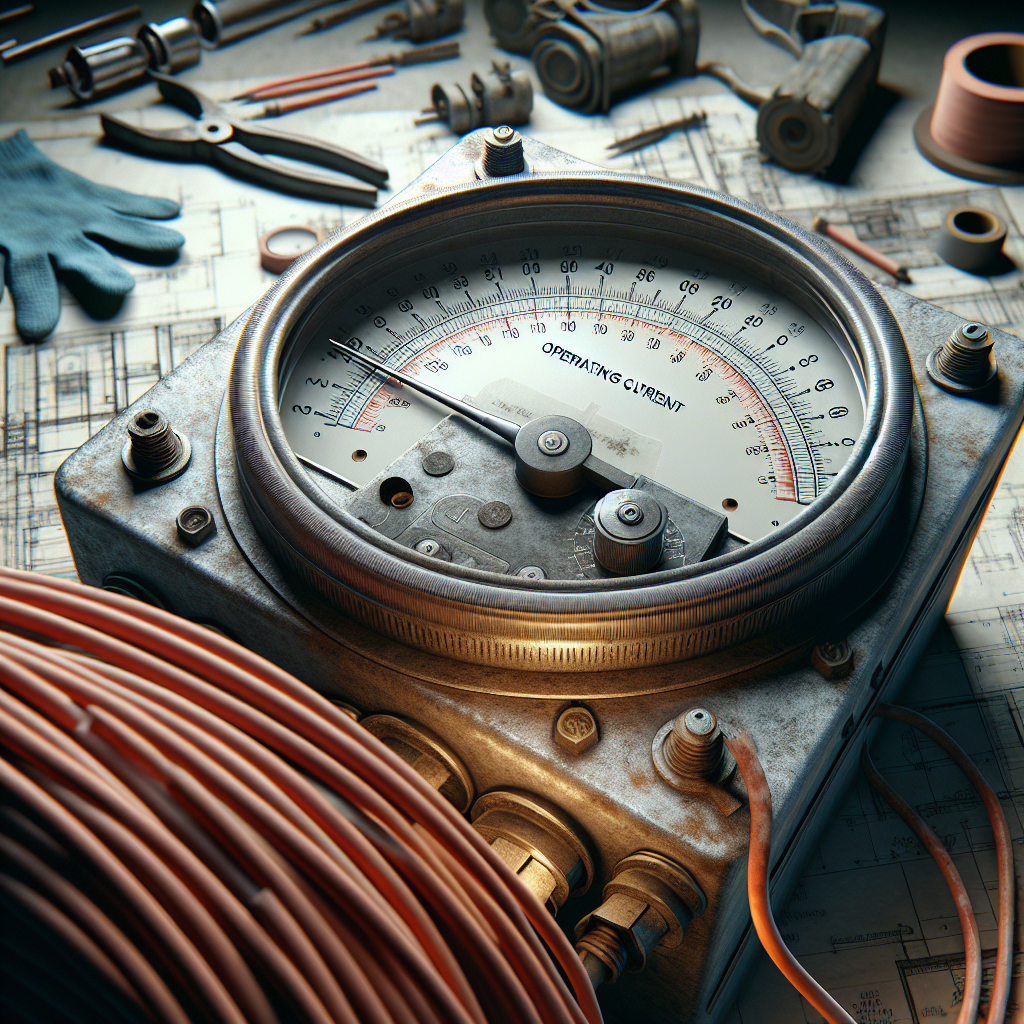Decoding Construction: Operating Current
Known as the lifeblood of electrical tools, ‘Operating Current’ is no alien term in the construction field.
It refers to the amount of electric current that a device or system uses under normal conditions.
This is an essential aspect of construction because the level of current impacts how tools function. It also plays a significant role in ensuring safety protocols are met.
Let’s explore this concept a little more.
Table of Contents
Understanding Construction Terms: Operation Current

Definition of Operation Current
Operation Current, or also known as operating current or operating current load, refers to the amount of current flowing in a circuit during normal operation. It is the electrical current required to power a particular electrical device, machinery, or system when functioning under regular operating conditions.
Key Points about Operation Current:
- It is crucial to understand the operation current of equipment to ensure proper electrical supply and prevent overloading circuits.
- Operation current is typically measured in Amperes (A) and can vary depending on the electrical load of the machinery.
- Knowing the operation current is essential for proper circuit design, equipment sizing, and electrical safety precautions on construction sites.
Importance of Operation Current in Construction
For construction projects, understanding the operation current of various equipment and systems is essential for efficient and safe operations. By calculating and planning for the operation current requirements, construction professionals can ensure that electrical systems are designed to handle the necessary load without risks of overheating or electrical failures.
| Benefits of Understanding Operation Current: |
|---|
| Prevents electrical overloads and short circuits. |
| Helps in selecting appropriate circuit protection devices. |
| Facilitates proper electrical system maintenance and troubleshooting. |
Operation current plays a crucial role in the successful implementation of construction projects, ensuring that electrical systems operate safely and efficiently. By comprehending and considering the operation current requirements of equipment, construction professionals can uphold electrical standards, prevent hazards, and maintain a productive working environment on the job site.
Distinguishing Between Operation Current and Rated Current
Understanding the operation current is fundamental in construction and similar industries. However, this concept is often confused with another major term: rated current. Being able to differentiate between these two and understanding how one interacts with the other is vital to instrumenting effective and safe electrical systems.
Defining Rated Current
Rated current, also known as nominal current or full load current, could be defined as the maximum current that a device, component or conductor can carry continuously without exceeding its temperature rise.
Aspects of Rated Current:
- Rated current is determined by the manufacturer in a standardised test condition.
- It is usual for the rated current to be less than the maximum current that a device can handle momentarily, without being damaged.
- The rated current also plays a key role in the selection of protection devices such as circuit breakers or fuses.
Contrasting Operation Current and Rated Current in Construction
Though these terms seem similar, operation current and rated current fulfill different roles in evaluating the electrical safety and function of equipment. While operation current refers to the actual current drawn under typical operating conditions, rated current signifies the maximum current that an electrical device can handle on a continuous basis without overheating or potentially causing damage.
| Contrasts Between Operation Current and Rated Current: |
|---|
| Operation current describes the typical current flowing when working under normal conditions, whereas rated current designates the limit that should not be exceeded continuously. |
| Operation current aids in defining the regular electrical supply required, while the rated current assists in stipulating device specifications and safety mechanisms. |
The Role of Rated Current in Device Selection and Safety
Understanding the rated current is crucial to ensure that construction professionals select the right equipment for their electrical system. It also plays a significant part in determining the correct protection components, such as fuses and circuit breakers, that prevent damage due to overloading or short circuiting.
Defining Miniature Circuit Breaker (MCB) Operating Current
In the sphere of construction and electrically driven projects, another important term relating to operation current is the ‘MCB operating current.’ This is a vital concept that ensures safe and effective electrical device operation.
What is MCB?
A Miniature Circuit Breaker (MCB) is an automatically operated electrical switch designed to protect an electrical circuit from damage caused by excess current from an overload or short circuit. It offers more precise levels of protection and features better sensitivity to temperature variations than a conventional fuse.
Features of an MCB:
- MCBs are designed to protect electrical equipment and circuitry via interruption of electrical flow upon detection of imbalances.
- They provide a secure method of electrical applications, protecting against damages arising from electrical overloads, short circuits, and imbalances in the load.
- Their turnover switch design lets users quickly identify tripped circuits caused by overheating.
What is the Operating Current of an MCB?
The operating current of an MCB, often termed as the “rated current,” is the maximum current which the MCB can carry continuously without tripping. Different types of MCBs accommodate varying levels of operating current, and they are typically classified based on their maximum allowed current loads.
Importance of MCB Operating Current:
- MCB operating current is pivotal for selecting the right MCB type for a particular device or circuit.
- Choosing an MCB with the accurate operating current prevents potential electrical hazards such as overheating or fires due to overloading.
MCB Operating Current and Its Significance in Construction
In construction, understanding the MCB operating current of the various electrical devices utilized can drastically reduce electrical hazards and improve site safety. By choosing correct MCBs based on their operating currents, one can ensure that the electrical circuits in the construction site are effectively protected from overloads or malfunctions.
| Contributions of MCB Operating Current to Construction Safety: |
|---|
| Suitably chosen MCBs based on operating currents help maintain the integrity of electrical circuits at the construction site. |
| With the right MCBs in place, potential electrical risks due to overheating or fires are significantly reduced. |
| Understanding MCB operating current aids in device selection, ensuring a smooth construction operation with minimal downtime. |
MCB operating current is an essential consideration in the electrical safety protocols of a construction site. Properly understanding this figure enables the selection of appropriate MCBs, maintaining circuit integrity and minimizing electrical hazards. As we continue to delve into electrical construction terminology, stay tuned for more detailed analyses and explanations to aid in your understanding of these critical concepts!
Understanding the Relevance of Start-up Current
Another essential facet related to operation current is ‘Startup Current.’ Also known as inrush current, this term is equally significant in electrical engineering and construction.
What is Start-up Current?
Start-up current or inrush current refers to the brief burst of high current drawn by an electrical device at power up. When an electrical device starts from an “off” state, there is a brief period where it requires a larger current above its normal operation current to reach its normal operating condition.
Key Aspects of Start-Up Current:
- Startup current typically exceeds the operation current and rated current of a device because machinery often needs extra power to move from a static state into motion.
- Identifying startup current is important to prevent potential equipment damage and electrical malfunction due to this initial, transient current spike.
- The duration of the inrush current is usually less than a second, but it can still cause potential electrical hazards if not accounted for.
Start-up Current and its Influence on Construction
Addressing inrush current in construction is crucial to avert potential electrical system failures. The inrush current needs to be looked upon while sizing the power supply elements and designing circuit protection measures.
| Impacts of Start-up Current in Construction: |
|---|
| High inrush currents can lead to equipment damage, fuse blowing, or lessen the lifespan of electrical components. |
| Proper accounting of start-up current ensures stability and reliability of electrical systems in the construction process. |
| Neglecting start-up current may lead to regular supply interruptions, which can delay construction progress. |
Understanding the concept of start-up current is as essential as grasping other electrical terms like operation current and rated current. In a field like construction, where ensuring electrical safety and reliability is paramount, start-up current plays a significant role in planning and maintaining stable electrical systems.
Conclusion
Understanding operation current is vital in the construction industry to ensure the safe and efficient operation of electrical systems.
By being aware of the current requirements of equipment and machinery, construction professionals can prevent hazards, maintain electrical standards, and create a productive work environment on site.






